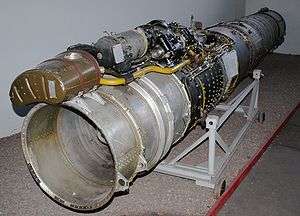Tumansky RD-9
The Tumansky RD-9 (initially designated Mikulin AM-5) was an early Soviet turbojet engine, not based on pre-existing German or British designs. The AM-5, developed by scaling down the AM-3[1], was available in 1952 and completed testing in 1953; it produced 25.5 kN (5,700 lbf) thrust without afterburner. AM-5 engine is notable for making the first Soviet supersonic interceptor possible, the MiG-19 and the first all-weather area interceptor, the Yak-25.[2] When Sergei Tumansky replaced Alexander Mikulin as the OKB-24's chief designer in 1956, the engine was renamed RD-9. The engine was later built under license in China as the WP-6.
| RD-9 | |
|---|---|
 | |
| Preserved Tumansky RD-9B turbojet engine | |
| Type | Turbojet |
| Manufacturer | Tumansky |
| First run | 1953 |
| Major applications | Yak-25 MiG-19 |
Variants and applications
- RD-9A
- RD-9B
- Used in the East German civilian jetliner project Baade 152 in 1958 and 1959, replaced when Pirna 014 engines became available.
- RD-9AK
- Non-afterburning versions for the Yak-25 and Yak-26.
- RD-9AF-300
- Afterburning version for the Yak-27 and Yak-28.
- RD-9AF2-300
- Afterburning version for the Yak-27 and Yak-28.
- RD-9B
- Afterburning version for early MiG-19s.
- RD-9BK
- Version for Lavochkin La-17M.
- RD-9BF-811
- Afterburning version for later MiG-19s.
- RD-9V
- Afterburning version used in the Ilyushin Il-40P.
- WP-6
- Chinese built version for the Shenyang J-6.
- WP-6A
- a Chinese upgraded version for the Nanchang Q-5 and J-6C.
- WP-6Z
- further developed for the cancelled Nanchang J-12
- NK-TJ
- [lower-roman 1] North Korean version built for MiG-19 and Shenyang J-6[3]
Specifications (RD-9BF-811)
Data from
General characteristics
- Type: Afterburning turbojet
- Length: 5,560 mm (219 in)
- Diameter: 670 mm (26 in)
- Dry weight: 725 kg (1,600 lb)
Components
- Compressor: Single-spool 9-stage Axial compressor
Performance
- Maximum thrust: 3,000 kgf (6,600 lbf, 29 kN) military power, 3,750 kgf (8,300 lbf, 37 kN) with afterburner
- Turbine inlet temperature: 860 ° C
- Specific fuel consumption: 104 kg/(h·kN) (1.02 lb/(h·lbf)) military power, 169 kg/(h·kN) (1.66 lb/(h·lbf)) with afterburner
- Thrust-to-weight ratio: 5.2
gollark: =tex O²W
gollark: I'm sure someone on the esolangs server demonstrated that the mathbot calculator (`== whatever`) was Turing-complete.
gollark: This may have been a bad idea.
gollark: Would this be the mystical ”function monad”?
gollark: They practically write themselves.
Notes
- designation is just a placeholder
References
- Belyakov, R.A.; Marmain, J. (1991). MiG 1939-1989. Paris: Editions Larivière. p. 137. ISBN 2-907051-00-8.
- Leonard, Barry (January 2011). History of Strategic and Ballistic Missile Defense: Volume II. DIANE Publishing. p. 245. ISBN 9781437921311.
- http://bemil.chosun.com/nbrd/bbs/view.html?b_bbs_id=10162&num=9
- The Osprey Encyclopedia of Russian Aircraft: 1875-1995, Bill Gunston, ISBN 1-85532-405-9.
External links
| Wikimedia Commons has media related to Tumansky RD-9. |
This article is issued from Wikipedia. The text is licensed under Creative Commons - Attribution - Sharealike. Additional terms may apply for the media files.